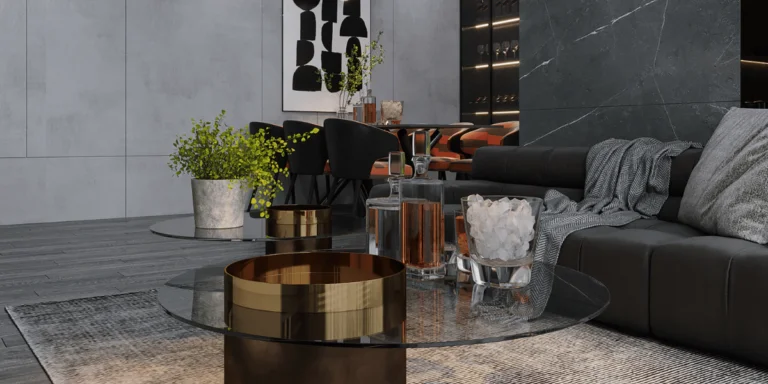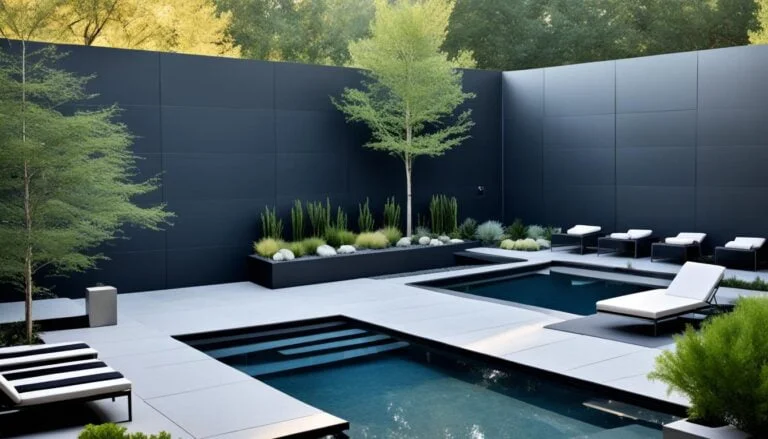Transforming your outdoor space into a stunning eco-haven is easier than you think. With artistic garden layouts and creative design ideas, you can create a beautiful and sustainable garden that will impress both friends and the environment.
Whether you have a small urban garden or a spacious yard, there are endless possibilities to incorporate sustainable practices and innovative design techniques. From sustainable urban gardening to eco-friendly landscape design, you can create an environmentally friendly haven in your own backyard.
Sustainable urban gardening allows you to make the most of your space, whether it’s a small balcony or a backyard. With space-efficient vertical gardening, you can grow a variety of plants while maximizing your limited space.
When it comes to eco-friendly landscape design, there are countless ways to conserve water and reduce your garden’s environmental impact. Innovative water conservation techniques, such as rainwater harvesting and drip irrigation, can help you minimize water waste and create a more sustainable garden.
By incorporating these sustainable practices and embracing creative design ideas, you can create an artistic garden that not only looks beautiful but also benefits the planet. So let your imagination run wild and create a garden that is both aesthetically pleasing and environmentally friendly!
Key Takeaways:
- Artistic garden layouts offer a way to create a unique and beautiful outdoor space.
- Sustainable urban gardening and eco-friendly landscape design can be incorporated into your garden.
- Space-efficient vertical gardening is perfect for small gardens.
- Innovative water conservation techniques can help minimize water waste.
- By combining sustainable practices and creative design ideas, you can create an artistic garden that is both beautiful and eco-friendly.
Small Gardens with Big Impact
When it comes to creating artistic garden layouts, small gardens can make a big impact. Despite their limited space, they provide the perfect opportunity to unleash your creativity and maximize every inch available. With a range of gardening designs specifically tailored for small spaces, along with innovative techniques like vertical gardening, it’s possible to transform even the tiniest garden into a beautiful and artistic oasis.
Whether you live in a bustling city or have a small backyard, there are plenty of design ideas that can turn your compact garden into a stunning outdoor retreat. Urban garden designs, in particular, are geared towards maximizing space efficiency and making the most out of every corner. With careful planning and strategic placement of plants, furniture, and decorative elements, you can create a visually appealing garden that feels much larger than it actually is.
One space-efficient vertical gardening technique that works wonders in small gardens is the use of vertical planters and hanging pots. These allow you to grow a variety of plants, herbs, and flowers while taking advantage of the vertical space available. Vertical gardening not only adds a unique aesthetic touch to your garden but also maximizes growing area, ensuring that no space goes to waste.
Gardening Designs for Small Gardens
When it comes to gardening designs for small gardens, it’s essential to focus on creating a sense of balance and visual interest. One popular design approach is to use different levels and heights, such as raised beds, trellises, or tiered planters. By incorporating these elements, you can add depth and dimension to your garden, making it more visually appealing.
Consider using plants with varying heights and textures to add layers of interest to your garden. Mixing flowers, shrubs, and ornamental grasses can create a lush and dynamic landscape even in a small space. Additionally, strategically placed mirrors or reflective surfaces can create the illusion of more space, making your garden appear larger and more expansive than it actually is.
Space-Efficient Vertical Gardening
Vertical gardening is a space-efficient technique that maximizes the potential of small gardens. By utilizing vertical structures such as walls, fences, or trellises, you can create a stunning display of plants while saving precious square footage. The key to successful vertical gardening is to choose plants that are well-suited for this type of cultivation.
Herbs, trailing vines, and compact flowering plants are great choices for vertical gardening. These plants not only take up less space but also provide a cascading effect when grown vertically, adding depth and visual interest to your garden. You can also experiment with vertical garden systems that incorporate hydroponics or other innovative growing methods to maximize the efficiency and productivity of your small garden.
With the right gardening designs and space-efficient techniques like vertical gardening, small gardens can have a big impact. Whether you’re turning a balcony into a lush oasis or transforming a narrow strip of land into a thriving garden, the possibilities are endless. Embrace the challenge of limited space and let your creativity bloom as you create an artistic garden that defies its size.
Creating Wildlife Habitat Gardens

Creating a wildlife habitat garden is not only visually appealing but also contributes to the preservation of biodiversity. By incorporating high-tech smart gardening techniques, such as using sensors and automation, you can create a sustainable and thriving environment for wildlife. Urban permaculture practices, such as companion planting and water conservation, can also be integrated into the design to promote a healthier ecosystem. Additionally, implementing organic composting methods and exploring the concept of green roof ecosystems can further enhance the environmental benefits of your garden.
If you’re looking to attract local wildlife to your garden, here are some tips:
- Plant a variety of native flowers, shrubs, and trees to provide food and shelter for birds, butterflies, and other wildlife.
- Set up bird feeders and birdhouses to create a welcoming space for different bird species.
- Install a water feature like a pond or a birdbath to offer a water source for animals.
- Create different levels in your garden by adding trees, bushes, and ground covers to provide a variety of habitats.
- Use natural materials, such as rocks and logs, to create hiding spots and nesting areas for wildlife.
High-Tech Smart Gardening
Embracing high-tech smart gardening can revolutionize the way you manage your wildlife habitat garden. By using sensors and automation, you can monitor and control essential factors like soil moisture, temperature, and light levels to ensure optimal conditions for plant growth and wildlife interaction. Smart irrigation systems can efficiently water your garden based on weather conditions, preventing water waste while keeping your plants healthy. Additionally, automated pest control methods, like electronic repellents or timed release of beneficial organisms, can help control pests without harming the ecosystem.
Urban Permaculture Practices
Urban permaculture practices are an excellent way to create a sustainable wildlife habitat garden within an urban environment. Companion planting, the practice of growing compatible plant species together, helps create a natural balance in the garden by attracting beneficial insects and repelling pests. Water conservation techniques, such as collecting rainwater and utilizing drip irrigation systems, are crucial for reducing water consumption and promoting the health of your garden. Implementing permaculture principles in your garden design can offer a holistic approach to sustainability and biodiversity preservation.
Organic Composting Methods
Organic composting is an essential aspect of wildlife habitat gardens. By recycling kitchen scraps, yard waste, and other organic materials, you can produce nutrient-rich compost to enhance the quality of your soil. Adding compost to your garden beds helps improve soil structure, water retention, and nutrient availability, creating a healthy foundation for plant growth. Organic composting methods also contribute to reducing landfill waste and minimizing the need for synthetic fertilizers, making it an eco-friendly choice for your garden.
Exploring Green Roof Ecosystems
Green roof ecosystems are a unique and innovative way to create wildlife habitat gardens in urban areas with limited space. By installing vegetation on the roofs of buildings, you can create additional habitats for birds, insects, and even small mammals. Green roofs help regulate temperature, reduce stormwater runoff, and improve air quality, making them a sustainable choice for urban gardening. Additionally, they can be a visually striking feature that adds beauty and biodiversity to cityscapes.
By incorporating these practices and techniques into your wildlife habitat garden, you can create a thriving ecosystem that supports local wildlife while adding beauty and sustainability to your outdoor space.
| Benefit | Description |
|---|---|
| Preserves Biodiversity | Creating a wildlife habitat garden contributes to the preservation of diverse plant and animal species. |
| Enhances Sustainability | High-tech smart gardening, urban permaculture practices, and organic composting methods promote eco-friendly and sustainable gardening practices. |
| Improves Environmental Health | Green roof ecosystems and natural pest control methods contribute to improving air quality and reducing the need for harmful chemical pesticides. |
| Creates a Beautiful Outdoor Space | By incorporating wildlife-friendly elements and native plants, you can create a visually stunning garden. |
Incorporating Contemporary Garden Artistry

Contemporary garden artistry is all about infusing artistic elements into the design of your garden. By incorporating biophilic design principles, you can create a space that fosters a deep connection between humans and nature. This approach not only enhances the visual appeal of your garden but also transforms it into a calming and inviting oasis.
One way to enhance your garden with contemporary artistry is through smart garden automation. With automated irrigation systems and smart lighting, you can effortlessly maintain and enhance the functionality of your garden. These automated features save time and eliminate the hassle of manual maintenance. Imagine your garden instantly coming to life with the perfect amount of water and the right lighting ambiance.
Indoor hydroponic systems offer another innovative way to incorporate greenery into your living space. These systems, which use water-based nutrient solutions instead of soil, allow you to grow plants indoors, regardless of the weather conditions outside. From herbs and leafy greens to decorative plants, indoor hydroponic systems provide a convenient and sustainable way to bring nature into your home.
Another aspect of contemporary garden artistry is green garden renovation. By implementing eco-friendly practices, you can transform your existing garden into a more sustainable and environmentally conscious space. From using organic fertilizers to installing water-saving mechanisms, there are various ways to make your garden greener and reduce its ecological footprint.
Benefits of Incorporating Contemporary Garden Artistry
When you embrace contemporary garden artistry, you unlock a world of benefits for both you and the environment. Let’s take a look at some of the key advantages:
- Enhanced aesthetic appeal: By incorporating artistic elements, your garden becomes a visually stunning masterpiece.
- Improved well-being: Biophilic design principles create a sense of tranquility and improve mental well-being.
- Efficiency and convenience: Smart garden automation simplifies garden maintenance and saves time.
- Year-round gardening: Indoor hydroponic systems enable you to grow plants indoors regardless of the season.
- Environmental sustainability: Green garden renovation techniques reduce the impact on the environment and promote eco-friendly practices.
| Contemporary Garden Artistry | Benefits |
|---|---|
| Integration of artistic elements | Enhanced aesthetic appeal |
| Biophilic design principles | Improved well-being |
| Smart garden automation | Efficiency and convenience |
| Indoor hydroponic systems | Year-round gardening |
| Green garden renovation | Environmental sustainability |
By incorporating contemporary garden artistry, you can create a visually captivating space that enhances your well-being, embraces sustainable practices, and adds a touch of artistic flair to your garden. Whether you’re a seasoned gardener or just starting, exploring these creative and innovative design approaches is sure to breathe new life into your outdoor haven.
Conclusion
Artistic garden layouts offer a unique opportunity to express your creativity while incorporating sustainable practices. By implementing innovative design ideas and eco-friendly gardening techniques, you can transform your outdoor space into a stunning eco-haven that not only looks beautiful but also contributes positively to the environment.
Whether you have a small garden with limited space or a more expansive yard, there are endless creative ideas to explore. From designing small gardens with big impact to creating wildlife habitat gardens, there are options for every preference and space. By embracing contemporary garden artistry and integrating biophilic design principles, you can bring beauty, tranquility, and sustainability together in your garden.
With a focus on sustainable practices and a commitment to eco-friendly gardening, you can make a significant impact on the environment. By incorporating techniques such as vertical gardening, water conservation, and organic composting methods, you can minimize waste and promote a healthier ecosystem.
So, don’t hesitate to explore the world of artistic garden layouts and let your creativity bloom. With a combination of innovative design, sustainable practices, and eco-friendly gardening, you can create a garden that not only reflects your unique style but also makes a positive difference in the world.
FAQ
What are some creative design ideas for artistic garden layouts?
There are several creative design ideas for artistic garden layouts, including sustainable urban gardening and eco-friendly landscape design. You can also incorporate innovative water conservation techniques and renewable energy in your eco-garden. Another option is to create a wildlife habitat garden or explore high-tech smart gardening practices. Vertical gardening is a space-efficient technique that can be used in small gardens as well.
How can I create a beautiful garden in a small space?
Even with limited space, you can create a stunning garden. Consider garden designs specifically tailored for small spaces. Vertical gardening, where plants are grown vertically on walls or in containers, is also a space-efficient technique. Using innovative design ideas and space-saving techniques, you can make the most out of every inch and transform your small garden into a beautiful oasis.
How can I create a wildlife habitat garden?
To create a wildlife habitat garden, you can incorporate high-tech smart gardening techniques such as using sensors and automation. Urban permaculture practices, such as companion planting and water conservation, can also contribute to a healthier ecosystem. Additionally, implementing organic composting methods and exploring the concept of green roof ecosystems can further enhance the environmental benefits of your garden.
What is contemporary garden artistry?
Contemporary garden artistry focuses on integrating artistic elements into garden design. By incorporating biophilic design principles that emphasize the connection between humans and nature, you can create a more calming and inviting space. Smart garden automation, such as automated irrigation systems and smart lighting, can enhance the functionality and convenience of your garden. Indoor hydroponic systems offer a way to bring greenery indoors, while green garden renovation techniques can revitalize an existing garden and make it more environmentally sustainable.
How do artistic garden layouts contribute to sustainability?
Artistic garden layouts allow you to express creativity while incorporating sustainable practices. By implementing innovative design ideas and eco-friendly gardening techniques, you can create a garden that is both visually appealing and environmentally friendly. From small gardens with big impact to wildlife habitat gardens, there are options for every space and preference, making it possible to transform your outdoor space into a stunning eco-haven.










